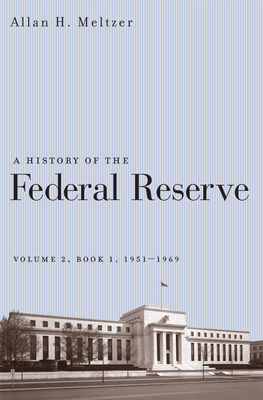A History of the Federal Reserve, Volume 2, Book 1, 1951-1969
Allan H. Meltzer

The second of three books of Meltzer’s exhaustive history of the Federal Reserve. I would also say it is exhaust-ing at times, but a fascinating read for anyone interested in monetary policy history (a very small group of people that includes me). This book covers a period bookended by the Fed-Treasury accord, which restored some measure of independence to the FR, and the beginning of the Great Inflation of the late 1960s and 1970s.
As with a classical tragedy, it is sometimes painful to watch the action unfold while knowing the grim ending that is coming. In particular William McChesney Martin (chair for much of the action) comes across as a somewhat tragic figure, a man whose goals are admirable but who fails to reach them through a deferent and consensus-building leadership style, as well as a misplaced trust in the partnership of presidential administrations (particularly LBJ’s).
There is no doubt that the FR bears much responsibility for the Great Inflation, but I think a few lessons stood out to me in this volume:
1. Fed independence was subordinated to administration policy not through hardball tactics from the White House, but by a kind of soft “capture.” We see Fed leaders, including the chairmen Martin and Burns, relishing the role of vizier to the president and, perhaps, as CS Lewis would have it, admittance to the “inner ring.” They do not see that they pay a price for that admission, which includes giving the administration the benefit of the doubt even when they have shown they are not worthy of it. (Tyler Cowen’s phrase that “the monetary authority moves last” shows how far we have come since the period covered by this volume.)
2. Economic models matter. Meltzer in this volume derides (rightly I think) the way the FOMC set directives to the account manager to operate policy according to the “tone and feel” of the market. This reflected a lack of consensus, and worse, an unwillingness to admit that the committee did not hold clear goals or have a real framework for thinking about how monetary policy operated. Furthermore, the policy errors of this period largely stemmed from a reliance on the correlational Phillips Curve, which implied that it was possible to “trade off” some increased inflation for increased employment, even in the long run. Economists including Milton Friedman had already shown by this time how the role of expectations invalidated this assumed relationship. (This prior error makes me a bit uneasy about the current movement for NGDP targeting, which seems like it enfolds a similar relationship.)
3. The weight on the Fed’s policy objectives (high employment and low inflation) is unclear, something the Fed continues to struggle with today. Even if there is no permanent tradeoff between unemployment and inflation available to policymakers, it seems that there are circumstances where the two objectives are in tension. Meltzer tends to come down very hard in favor of controlling inflation, and perhaps this is appropriate, particularly if the central bank has more control over inflation than it does over employment. But it’s interesting to note, as Meltzer does in the text, that even as the Great Inflation commenced, a relatively small proportion of the American population cited inflation as a major problem in their lives. There are unavoidable distributional effects that Meltzer only touches on in a minor way: unemployment vs. inflation pits the working-age population against retirees, and those whose wealth primarily consists of their labor capacity against those whose wealth primarily consists of financial assets. The existence of these distributional consequences, it seems to me, raises the question of whether it is really preferable to have a monetary authority that is truly independent of the electorate.
As with the first volume, this book simultaneously made me proud at how far my institution has come in the intervening years, and humbled because it seems almost certain that we today are not exempt from unnoticed errors on the scale of those committed in the ’60s.